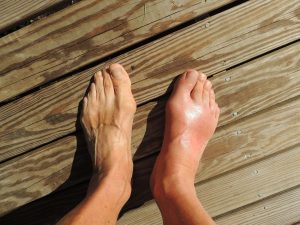
Gout is a painful and complex form of arthritis that can cause extreme discomfort and even disability. It is caused by a buildup of uric acid in the joints, leading to inflammation and swelling. Gout is most commonly seen in the big toe, but it can occur in any joint. It is most common in men, especially those over the age of 40, but it can affect women as well.
The symptoms of gout are quite unpleasant. When someone experiences a gout attack, they will likely feel sudden and severe pain in the affected joint. This pain can be quite intense and is usually accompanied by swelling, redness, and warmth at the site of the attack. Gout attacks can last anywhere from a few hours to several days, and they may be recurring.
When someone experiences these symptoms, a doctor may suspect gout and take a medical history. This includes questions about diet, family history, and any medications the patient is taking. Doctors may also order blood tests to measure the level of uric acid in the patient’s blood. High levels of uric acid confirm the diagnosis of gout. The doctor may also order an X-ray or MRI to get a better view of the affected joint. These tests can help rule out other causes of the pain, such as an infection or fracture.
There are a few risk factors that are associated with developing gout. One of the most common is having a diet high in purine-rich foods, such as organ meats, seafood, and alcohol. Being overweight and having certain medical conditions, such as diabetes or hypertension, can increase the risk of developing gout. Taking certain medications, such as diuretics, can also increase the chances of developing gout.
In order to reduce the risk of gout and manage the condition, it is important to make some lifestyle changes. It is advised to limit the intake of purine-rich foods, alcohol, and sugary drinks. Eating a healthy, balanced diet and exercising regularly can help to manage the condition. Drinking plenty of water can also help to flush out any excess uric acid from the body.
If lifestyle changes are not enough to manage the condition, there are medications that can help. Nonsteroidal anti-inflammatory drugs (NSAIDs) can help to reduce the pain and swelling associated with gout. Corticosteroids are also sometimes used to reduce inflammation. Other medications, such as colchicine and allopurinol, can help to prevent future gout attacks by reducing the levels of uric acid in the body.
Gout can be a very painful condition, but it can be managed with lifestyle changes and medications. It is important to speak to a doctor if you are experiencing any symptoms of gout, as it is important to get the right treatment and start managing the condition as soon as possible.
Recent scientific research has shown that there is a complex relationship between gout and other factors, including genetics, kidney function, and lifestyle. Genetic research has identified several genes that are associated with the development of gout. For example, one gene, SLC2A9, has been linked to increased uric acid production, which can lead to gout. Additionally, other genes have been identified that are associated with an increased risk of gout.
Kidney function is also important in the development of gout, as the kidneys are responsible for filtering and excreting uric acid from the body. Poor kidney function can lead to increased uric acid levels, thus increasing a person’s risk of developing gout.
Overall, research into gout has revealed that it is a complex condition that involves both genetic and lifestyle factors. By understanding the causes of gout, it is possible to reduce the risk of developing this painful condition.
Here is an interesting video on gout diet which may be helpful.